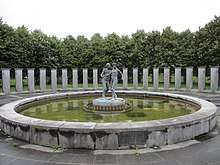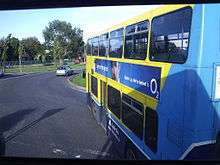Artane, Dublin
Artane, sometimes spelled Artaine (Irish: Ard Aidhin),[1] historically Tartaine[2] is a northside suburb of Dublin city, Ireland. It is also a civil parish in the ancient barony of Coolock.[3] Neighbouring districts include Kilmore West, Coolock, Beaumont, Killester, Raheny and Clontarf; to the south is a small locality, Harmonstown, straddling the Raheny-Artane border. Artane is also a parish in the Fingal South East deanery of the Roman Catholic Archdiocese of Dublin.
Artane Ard Aidhin | |
|---|---|
Suburb of Dublin | |
 Artane Location in Ireland | |
| Coordinates: 53°22′58″N 6°11′42″W | |
| Country | Ireland |
| Province | Leinster |
| County | Dublin |
| Local authority | Dublin City Council |
| Government | |
| • Dáil Éireann | Dublin Bay North |
| • EU Parliament | Dublin |
| Area | |
| • Suburb of Dublin | 3.86 km2 (1.49 sq mi) |
| Population (2006) | |
| • Urban | 36,564 |
| (Local election areas) | |
| Time zone | UTC+0 (WET) |
| • Summer (DST) | UTC-1 (IST (WEST)) |
| Area code(s) | 01, +353 1 |
| Irish Grid Reference | O176375 |
History

Artaine, now usually Artane, has a recorded history spanning over 900 years, but for much of that time was a quiet rural area.
Artane,[4] as described from Thom's Almanac and Official Directory: County Dublin Directory, in 1862:[2] A village and parish in Coolock barony, Dublin county, three miles (5 km) N. from the General Post Office, Dublin, comprising an area of 954 acres (3.86 km2). Population, 457. The village is on the road to Malahide. The parish, anciently called "Tartaine," for centuries formed part of the estate of the Hollywood family, and the castle of Artane likewise belonged to that of the Donnellans. The ruins were taken down in 1825, and on its site Artane House was erected.
Artane Castle was recorded from about 1360 when Robert de Holywood, Chief Baron of the Irish Exchequer and founder of the Hollywood family, purchased it.[5]
The civil parish of Artaine, linked with Finglas before the Reformation, comprises the townlands of Artaine North, Artaine South, Artaine West, Artaine East (originally Skillinglass), Puckstown (where Bram Stoker once resided with his family) and two-thirds of the townland of Oldtown (the remainder being in the civil parish of Coolock).
Artane Cottages Lower and Upper, built circa 1900, on the Malahide Road, are in the townland of Killester North.
Silken Thomas and Artane Castle
In 1534, when Silken Thomas appeared in Dublin, the citizens, feeling themselves unable to defend the city, allowed his troops to enter and lay siege to Dublin Castle. Among those who had taken refuge in the Castle was John Alen, Archbishop of Dublin. He had incurred the enmity of the FitzGeralds (also known as the Geraldines) by zeal in promoting Wolsey's plans, and now dreaded their vengeance. He tried to escape by sea, but his ship was driven ashore at Clontarf. He sought refuge at Artane Castle, the home of his friend and fellow councillor Thomas St. Lawrence: St. Lawrence willingly took him in, but his hiding place was betrayed and he was captured. When brought before Silken Thomas, he implored the Earl to spare his life, but the young lord turned away with contempt, saying "Beir uaim an bodach" ("take the fellow away").[6] These words were interpreted as an order to put him to death and he was murdered in cold blood. For this crime, Silken Thomas was excommunicated by the Pope and thus lost many of his adherents. A slab bearing his name is still to be seen in the Archbishop's cemetery. In this old cemetery, we also have the 18th century tomb of Richard Hollywood of Elm Park and the ruins of the 13th century parish church.
Artane Industrial School
The Artane Industrial School was set up in 1871 in Artane House by the Congregation of Christian Brothers. Industrial Schools were established to take in orphaned or abandoned boys or those who were involved in petty crime, and even such a minor offence as skipping school could be enough for a boy to be sent there.[7] It has been said that about 5% of the children in Artane, indeed in all Industrial Schools, were actually orphans. Most of the incarcerated children were from families that had broken down and as separation was not allowed either, the children of these broken marriages were incarcerated and the religious institution in whose charge the children were put were paid one-third of a labourer's wage to feed, educate and clothe each child. In today's money this would be equal to about €120 per child per week.
The school housed around 900 boys at any one time and they stayed there until they were 16 years of age.[8] More than 15,000 youngsters passed through the gates of the school from 1871 to its closure in 1966.[9] Subsequently, many allegations of abuse of boys at the school emerged.[10]
After the industrial school
St. David's Primary School, BNS, began operations on the lower floors of the old industrial school in 1969. St. David's Secondary School, CBS, moved into the upper floors of the industrial school building in 1974 from the pre-fabricated buildings on Kilmore Road which it had occupied since 1966. The school building remains today, with playing fields surrounded by a double fence.
The Stardust

The Stardust was a popular nightclub located near the Artane end of the Kilmore Road leading from Artane to Coolock. In the early hours of 14 February 1981, a fire took place at a disco. 48 people lost their lives and 214 were injured. 841 people had attended the disco that night. The site of the disaster is today a business park which houses (amongst other things) a pub, opposite Artaine Castle Shopping Centre. On the site was originally the factory of Scotts Foods, making jams and jarred vegetables. On 14 November 2008, a second fire occurred at the same site as the Stardust, which had been used as a children's play centre. However, no-one was in the building at the time, and there were no injuries. Once the fire was put out, firefighters found cancer-causing asbestos hanging from the roof.[11]
Amenities
Shopping precincts in the Artane area include several retail outlets on the Malahide Road, as well as the Artane Castle Shopping Centre, which is anchored by Tesco.[12][13]
There are two Roman Catholic churches serving the area: Our Lady of Mercy, Brookwood Grove (Artane parish), and St John Vianney, Ardlea Road (Ardlea parish).[14][15] Artane is also the site of the Coolock-Artane Credit Union main office, and the Donnycarney-Beaumont Credit Union, located in Artane Castle Shopping Centre.[13]
Schools in Artane include St. David's CBS and St. David's Boys National schools, as well as St. John of God Girls National School on Kilmore Road.[16]
Public transport

Dublin Bus
The area is served by a number of Dublin Bus routes, including: 14, 15, 27, 27B, 27X, 42, 42A, 42B 43, 104, 27a. The Artane roundabout bus stop is nearly always occupied by passengers.
DART
Artane is close to two Dublin Area Rapid Transit (DART) stations: Harmonstown railway station, which divides Artane and Harmonstown, and Killester railway station.
Notable people
- Robert de Holywood, founder of the Hollywood family and Chief Baron of the Irish Exchequer (died 1384).
- Birthplace of Stephen Cluxton, who scored the winning All-Ireland point for Dublin in 2011; attended St David's CBS.
- Birthplace of Thomas Kettle (1880–1916), writer, barrister, economist, Irish Nationalist politician, and World War I volunteer (KIA).
- Birthplace of Larry Mullen, drummer with the Irish band U2, and perhaps the most famous former member of the Artane Boy's Band.
- Ex-Big Brother star, now TV/radio presenter, Ray Shah grew up and went to school in St David's NBS & CBS, Artane; he went on to become a popular disc jockey.
- Birthplace of Brian McFadden, singer/musician.
- Birthplace of Brendan Gleeson, actor.
- Birthplace of Kevin Doherty, ex-footballer and former first team manager of Shelbourne FC.
- Actor Liam Cunningham was educated at St David's CBS.
- Footballer Frank Stapleton.
- Ex-professional cyclist and award-winning journalist Paul Kimmage grew up in Artane.
- BBC TV presenter Peter Snow.
- Ivan Beshoff, survivor of Russian battleship Potemkin lived in Artane, where he founded the Beshoff's chain of fish and chip shops
- British Airways CEO Willie Walsh was born near Artane.
- Veronica Guerin (1958–1996), Irish crime reporter, murdered during the course of an investigation.
- Johannes de Sacrobosco, known locally as John de Hollywood (1195–1256), is believed to have come from Artane.
- Born in Clontarf, Bram Stoker lived in Artane Lodge during the 1850s. His brother George was born in Artane.
- Actor Jason Barry of Titanic and Love/Hate fame is from Artane.
- Footballer Jeff Hendrick of Burnley and Ireland grew up in Artane playing with Artane Beaumont.
- Colombia goalkeeping coach Des McAleenan grew up in Artane.
- Music manager Nicky Ryan and wife Roma Ryan live in Artane.
References
- Multiple bases are found in multiple sources (which include {Dublin, 1984 – Wren, Jimmy: The Villages of Dublin}), including: Ard Tain, The Height of the Flocks; Ard Aidhean, Aidhean's Height; Ard In, The Little Height
- Dublin, 1862: Thom's Almanac and Official Directory
- Placenames Database of Ireland - Artaine civil parish
- http://www.buildingsofireland.ie/cgi-bin/displayimage.cgi?id=2433&size=f&type=m1
- Adams, C.L. Castles of Ireland London 1904 p.18
- Artane & Coolock
- Dickson, David (2014). Dublin: the making of a capital city. Cambridge, Mass.: Harvard University Press. p. 521.
- "Fear of the Collar: My Terrifying Childhood in Artane" by Patrick Touher
- "Archived copy". Archived from the original on 23 October 2008. Retrieved 2008-12-24.CS1 maint: archived copy as title (link)
- BBC News: http://news.bbc.co.uk/1/hi/world/europe/450088.stm
- "Stardust fire destroys Stardust site" The Sunday World, Dublin, 15 October 2008
- "Artane Castle, Dublin 5". rohanholdings.ie. Rohan Holdings Limited. Retrieved 24 June 2019.
- "Artane Castle Shopping Centre, Dublin" (PDF). cushmanwakefield.ie. Cushman Wakefield. Archived from the original (PDF) on 24 June 2019.
- "Parish Information - Artane". dublindiocese.ie. Retrieved 28 June 2019.
- "Parish Information - Ardlea". dublindiocese.ie. Retrieved 28 June 2019.
- "St. John of God G.N.S. - Contact Us". stjohnofgodartane.com. Retrieved 28 June 2019.